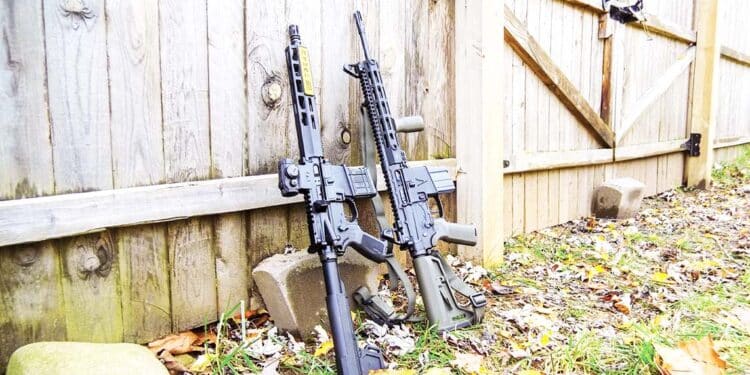By Josh Wayner
Back in the old days, having a short barrel on your gun typically meant that you were expecting something at close range. Target shooters had 6-inch barrels on their .38s. People who thought they might encounter a fight typically went with a barrel shorter than 2 inches. Longer guns are, and always have been, harder to bring up quickly and deploy when haste is the order of the day.
There has always been a tug-of-war between the overall length of a given type of weapon and the theory of end-use it has. Since we are talking primarily about AR-type rifles in this article, we’ll stick to that, but there is the necessary mention of the bullpup rifle. Many types of bullpup rifles allow a longer barrel length for shorter overall length by moving the action behind the grip, but there is the school of thought that says that ergonomics suffer as well as accuracy. Both of these things are true, as it is rare to find a comfortable, well-balanced and accurate bullpup rifle.
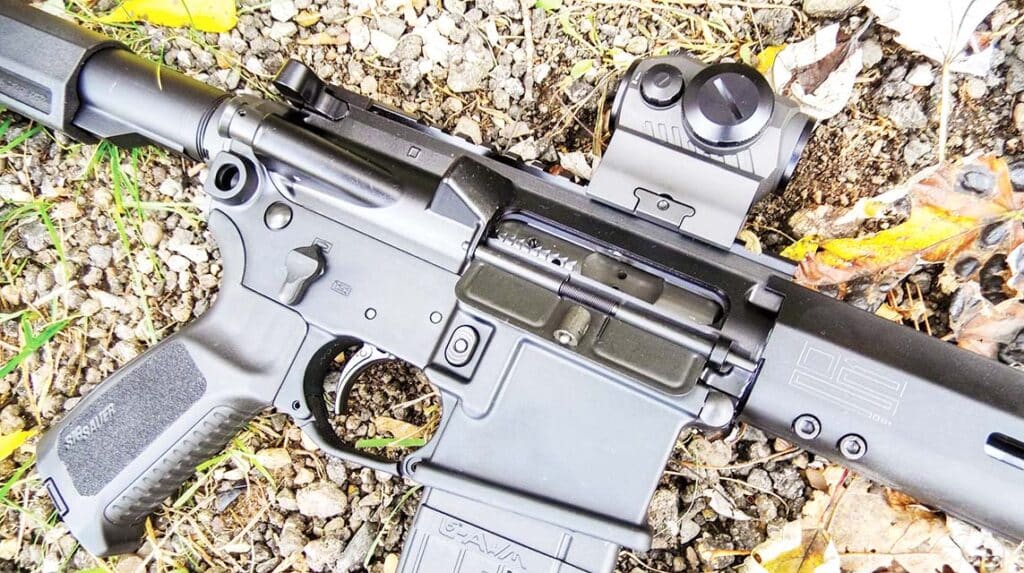
The most common barrel length for today’s AR platform rifles is 16 inches. This is the legal minimum without going the way of the NFA. The next two common lengths are 18 inches, usually found in SPR-type rifles, and 20 inches. The 20-inch length, while offering what is generally the highest velocity capabilities out of any of these barrel lengths, has fallen out of fashion with most crowds, the exception being National Match shooters.
The world of AR pistols is another animal entirely. Common barrel lengths in this class of firearms range from 7 inches to 11.5 inches. There is a significant difference between many of these pistol-length barrels, even from each other. For the most part, these barrel lengths in civilian hands have been somewhat of a novelty. Up until recently, with the introduction of the pistol stabilizing brace, they served almost no real functional purpose except for the “cool” factor.
Floating in the middle of this rifle and pistol dilemma is the pinned barrel. It is standard practice to pin and weld a muzzle device to a 14.5-inch M4 barrel to make it stretch out to the legal minimum of 16 inches. Some people prefer this, as it saves a little bit of overall length on the rifle, but it severely limits the ability of the gun to accept suppressors or other muzzle devices. Once you decide which one you want, it’s essentially going to stay there forever.
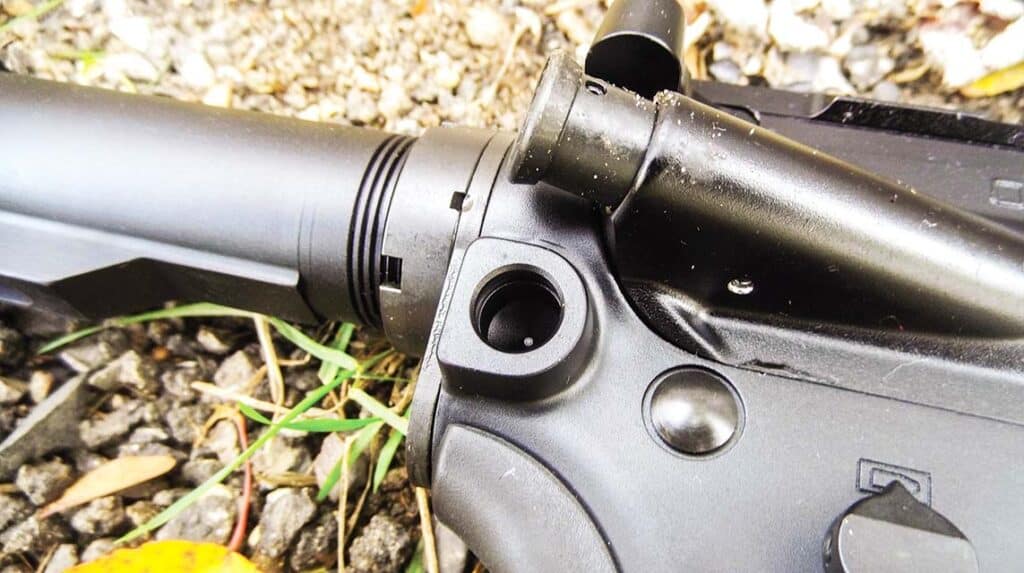
The modern theory of barrel length has evolved substantially, even in the last 5 years. Today’s weapon systems are substantially different than they were when introduced. Ammunition technology has increased dramatically, as has precision manufacturing. Because of this, there isn’t a tremendous functional difference between a 14.5-inch and a 20-inch barrel at most of the distances to which the 5.56mm cartridge is effective. Eight hundred yards are widely considered to be the furthest distance at which the 5.56mm is effective; although it will of course fly further. Five hundred yards are what most people consider the further limits for an off-the-shelf AR-type rifle. The sky’s the limit when it comes to upgrades, but the average man with a carbine and mid-powered optic is at his best inside 500 yards.
Another consideration is the prevalence of optics. Longer barrels have a longer sight radius and are thus comparatively more precise than a gun with a short site radius. If you were to take two identical scoped rifles and cut one barrel at 20 inches and another barrel at 16 inches, you would hardly notice a difference in the field. This is true not just for 5.56mm, but also for 7.62mm. A great many 7.62mm rifles are going to 16-inch barrels, even for precision shooting. The 7.62 reacmost of its velocity in just a foot of barrel. The author conducted testing some time ago with special bolt-action rifles with barrels as short as 13 inches and found no reason to go with barrels over 16 inches inside of 600 yards.
What it all comes down to basically, is that modern weapons are more compact and equally (or more) effective as their predecessors. A shorter barrel, 16 inches or less, is a do-all for most people.
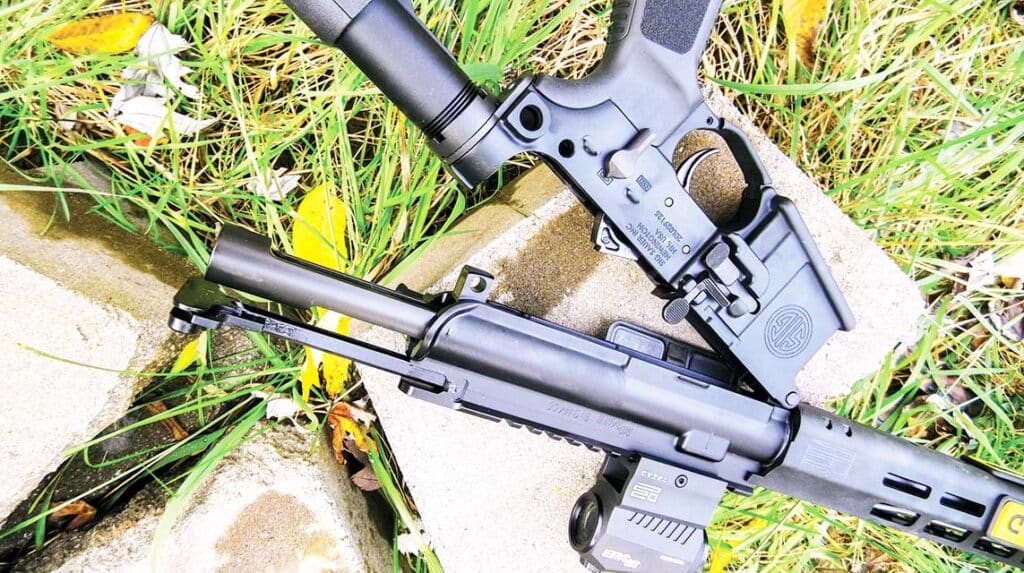
Probability of Hits
This topic deserved its own segment in this article. One of the major reasons why people choose long barrels is higher velocity. Many modern weapon systems don’t need to be small or compact. An excellent example of this is a cartridge that is designed around long barrels for long ranges and not general use. The 6.5 Creedmoor is a cartridge that has taken the shooting world by storm. On average, the standard barrel length for this cartridge is between 22 and 26 inches. That is not to say that it would be ineffective at something shorter, but you’re really not reaping the benefits and unless you can get the velocity up there, especially with 140-grain and above bullets.
Higher velocity equals a flatter trajectory. A flatter trajectory means a higher likelihood of hits at any given distance. Therefore, you think that having a short barrel on your gun means it is totally useless. In reality, there isn’t a huge difference between the M400’s 10.5-inch barrel and a 20-inch barrel at combat ranges inside 300 yards. With a red dot sight zeroed for 200 yards, there is a difference in terms of handling but not in the number of hits put on target. Greater precision can be achieved with sights like the Trijicon ACOG® if desired, though the bullet drop compensator will be off the further you get out there.
For the average carbine shooter, a 10.5-inch barrel is perfectly adequate on man-sized targets out to 300 yards. Would that person be better served with a 14.5-inch barrel or 16-inch barrel? Hard to say. Today’s AR pistols (and SBRs) are so good that many people who the author knows have not returned to longer barrels. The shorter weapons are infinitely more maneuverable and, thanks to advances in ammunition, are essentially just as effective.
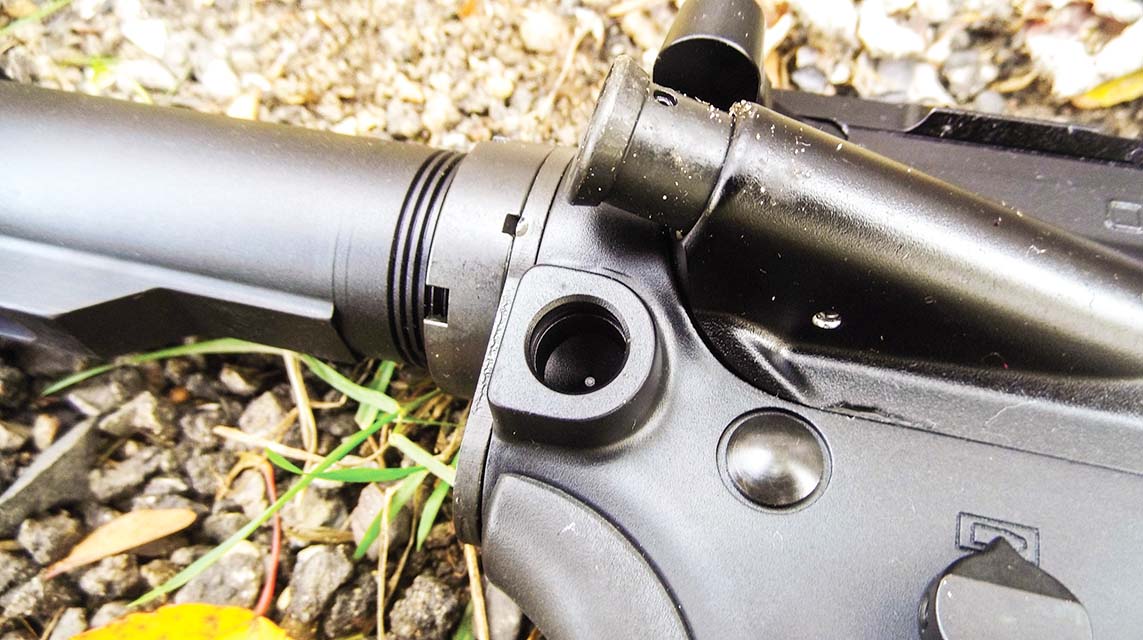
The M400 TREAD Pistol
SIG SAUER has been constantly innovating in recent years. They were among the first companies to embrace the idea of the pistol brace, and they continue to do so today with the M400. This article is not designed to go into the intricacies of the pistol brace and its controversial history, but its introduction and acceptance have been instrumental in normalizing short barrels for the general public. Pistol braces were really the first products that made the short-barreled AR into something more than just a range toy or novelty.
The pistol brace that comes with the M400 is surprisingly adjustable for length, just like an M4 stock. It has several points of adjustment and locks firmly into each. It is easy to get a good solid cheek weld. The footprint of the brace itself is minimalist, and some of the angles are not the most comfortable, but it is extremely functional and is certainly a step above the fixed braces otherwise available today.
The M400 is essentially SIG SAUER’s direct-gas standard AR. They make a variety of other systems that are piston-operated, but this one is compatible with all existing AR parts. The manual of arms and controls are identical to all standard AR-type systems. It should be noted that SIG SAUER has its own complete line of accessories for the M400, which is a big plus if you want to stay within the brand. Most of these parts are available through the company, and they encompass everything from hand stop kits to different types of sights.
In testing, there was no failure to feed or fire. The author received both rifle and pistol versions from the M400 TREAD line, and there were no failures of any kind to speak of. Accuracy was exceptional, but more on that later. What SIG SAUER managed to do with the M400 series is excellent in that it provides a complete system of weapon, optics, accessories and ammunition to the end user. Because it is all designed together, there isn’t much guesswork that goes into setting your gun up. If you’re looking for an upper-level entry class AR, you have to look quite far to beat what is available in the M400 product line at the cost.
As far as features go, the M400 TREAD pistol features a 10.5-inch barrel, a free-floating slim handguard, a black finish, multiple QD sockets, ambidextrous controls and neat slot covers that have the TREAD logo on them. They are removable, in case you’re wondering. When it is all said and done, this is a feature-loaded AR pistol that has everything you need and nothing you don’t.
The Test
To test rifle against pistol, the author assembled a lightweight 14.5-inch pin and weld rifle with the help of Brownells. All of the parts used to construct the lightweight carbine are available currently at Brownells, and all of them are sold off the shelf with no special tweaks.
The carbine features a Faxon Firearms barrel with an integrated flash hider. It makes use of many standard parts, but most prominently has a set of lightweight V7 receivers. The author wanted it to be as comparable in weight and size as possible to an AR pistol, but without crossing that line into pistol territory. The idea of the test was to see just how much of a difference there was between two guns that are comparable in size, weight and intended end use.
The Brownells’ build was finished and tested for reliability and accuracy. The author is an expert on the AR platform, and you should always consult a gunsmith before attempting to build one yourself at home. It is easy and quite straightforward, but a mistake can destroy your new parts and, worse, result in severe injury or death.
Both guns were zeroed for 25 yards. Accuracy at that distance was identical. While not a tremendous distance, 25 yards is where most competitions take place, and most ranges have bays at that distance. A 25-yard zero for most carbines will result in a trajectory that roughly places bullets’ center mass at 200 yards. While not as precise as a true zero at that distance, it is sufficient for most duty and match guns and certainly acceptable for most general use rifles.
The ammunition was tested for velocity to see how much of a difference it makes between a 14.5-inch and a 10.5-inch barrel. Velocity was recorded for the average of 10 shots over an Oehler 35P chronograph 10 feet from the muzzle. As you read the table, you will note that the baseline 16-inch velocity is not tremendously faster than the 14.5-inch. Overall, a roughly 300-fps difference could be detected from 10.5 inches to 16 inches. The general difference between a 10.5-inch and 14.5-inch could be considered roughly 200 fps. This is important in respect to the overall length choice, as a pinned and welded barrel doesn’t actually lose that much compared to a standard 16-inch. With some types of ammunition, it was hardly noticeable. A 200-fps difference between the 10.5-inch and 14.5-inch was much more noticeable but didn’t actually come into play much.
Once zeroed for 25 yards, the author took the guns out to 200m, about 220 yards. At that distance he fired on both paper silhouettes and steel plates. It was definitely easier to handle the carbine at that distance. The full stock and slightly better balance allowed it to edge out the M400 in general, but the contest was much closer than you would imagine. There was not a tremendous amount of difference on paper and steel. In fact, for most ammunition tested, the author achieved a 100% hit ratio at 200m.
At closer distances, it was also a close game. The M400 handled very well at short range, 25 to 50 yards, and it was pretty hard to tell them apart when steel was ringing. So what does this mean as far as you should be concerned?
The take away here is essentially that there is not a lot of difference between a 10.5-inch AR pistol and a 14.5-inch carbine. You would be well-served with both at short distances, which is where these guns excel. Past 200 yards, neither one does spectacularly well as compared to a 16-inch or 20-inch rifle.
A consideration when making a choice, especially for first-time buyer, would be what you want to achieve with the legal classification of your weapon. The AR pistol is legally a handgun and can be stored loaded and concealed in most states where you can carry handgun. There is not a distinction between it and other common pistols in that sense. If you store a weapon in your vehicle in case of an emergency, it makes great sense to do so with the legal protections you would have, considering the handgun status of this M400. That is not to say that a carbine could not be just as readily available. There are few, if any, areas that allow a rifle to be transported or carried while loaded. It could be argued that the time it takes to deploy an AR pistol could easily be spent loading a standard carbine, but that is based on personal need.
What Is Right for You?
Because of the fact that there are advantages to an AR pistol, especially one as well thought out as the M400, the casual AR enthusiast could bypass the carbine entirely and go for a pistol. Because it is shorter and more maneuverable in a home or an enclosed space where you may encounter danger, there is a distinct advantage to such a small overall package.
The technology and benefits of the AR pistol will continue to advance in the coming years. It is very likely that SIG SAUER will be at the forefront of those advancements as it continues to evolve and perfect its excellent products.
| BARREL LENGTH/VELOCITY | |||
| 16in | 14.5in | 10.5in | |
| Hornady Frontier M193 | 3,009fps | 2,939fps | 2,673fps |
| Hornady Frontier 62gr FMJ | 2,999fps | 2,905fps | 2,626fps |
| Hornady Frontier 55gr Match HP | 2,975fps | 2,850fps | 2,587fps |
| SIG 55gr FMJ | 2,840fps | 2,758fps | 2,469fps |
| Black Hills Ammo 50gr V-MAX | 3,033fps | 2,981fps | 2,679fps |
| This article first appeared in Small Arms Review V24N5 (May 2020) |



